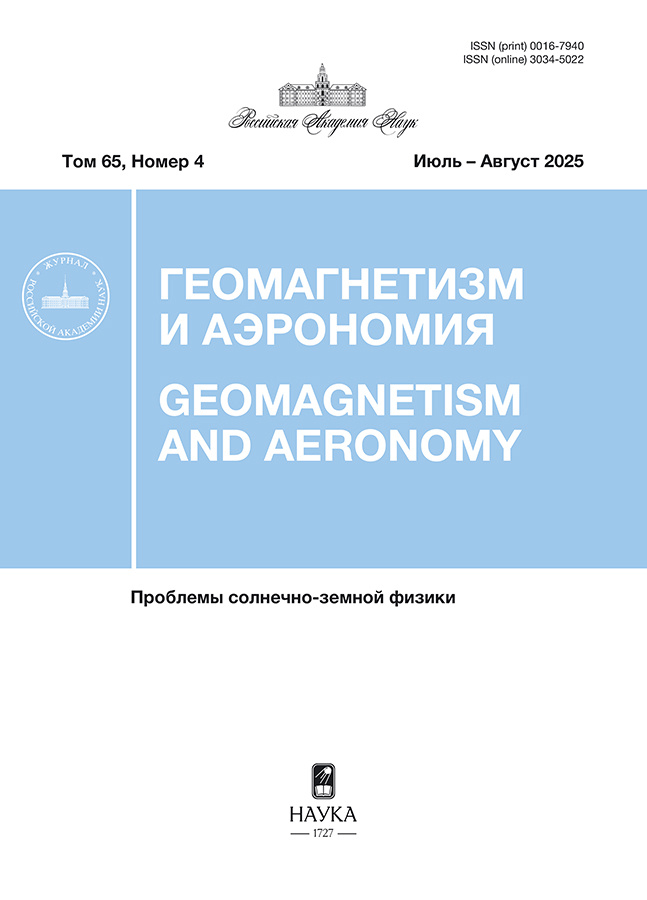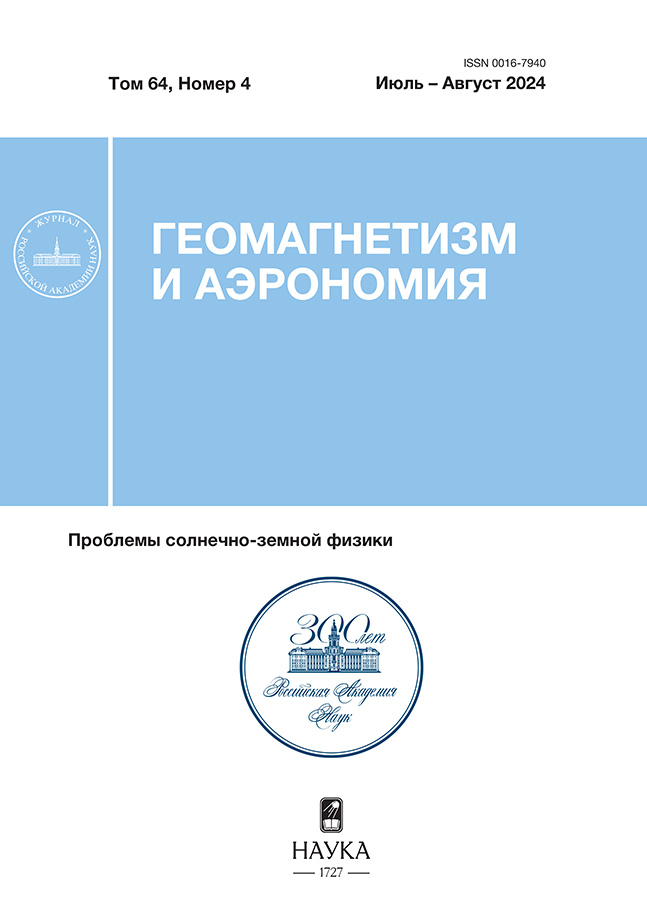Верификация эмпирической модели ионизации нижней ионосферы во время солнечных вспышек различного класса
- Авторы: Ряховский И.А.1, Поклад Ю.В.1, Гаврилов Б.Г.1
-
Учреждения:
- Институт динамики геосфер им. акад. М.А. Садовского РАН (ИДГ РАН)
- Выпуск: Том 64, № 4 (2024)
- Страницы: 512-518
- Раздел: Статьи
- URL: https://kazanmedjournal.ru/0016-7940/article/view/650921
- DOI: https://doi.org/10.31857/S0016794024040069
- EDN: https://elibrary.ru/RTQHJH
- ID: 650921
Цитировать
Полный текст
Аннотация
Использование результатов измерений параметров ОНЧ-сигналов, распространяющихся в волноводе Земля – D-область ионосферы, для оценки изменений состояния нижней ионосферы в результате воздействия рентгеновского излучения солнечных вспышек позволяет получить качественные данные о характере и величине воздействия. Получение точных данных о связи изменений электронной концентрации с параметрами вспышки и надежное прогнозирование условий распространения НЧ-радиоизлучения в условиях сильных геофизических возмущений затрудняется отсутствием полной информации о частотном спектре рентгеновского излучения при конкретной вспышке и данных о скорости ионизации ионосферы при вспышках различных классов. Предложенная авторами ранее методика определения рентгеновского спектра в широком диапазоне длин волн и расчета коэффициентов ионизации нижней ионосферы в зависимости от параметров ионизирующего излучения вспышек позволяет повысить точность оценок вариаций параметров нижней ионосферы. Настоящая статья посвящена проверке работоспособности разработанной эмпирической модели ионизации нижней ионосферы на фронте солнечных вспышек и сравнению полученных результатов с экспериментальными данными по изменению параметров ОНЧ-радиосигналов.
Ключевые слова
Об авторах
И. А. Ряховский
Институт динамики геосфер им. акад. М.А. Садовского РАН (ИДГ РАН)
Автор, ответственный за переписку.
Email: ryakhovskiy88@yandex.ru
Россия, Москва
Ю. В. Поклад
Институт динамики геосфер им. акад. М.А. Садовского РАН (ИДГ РАН)
Email: poklad@mail.ru
Россия, Москва
Б. Г. Гаврилов
Институт динамики геосфер им. акад. М.А. Садовского РАН (ИДГ РАН)
Email: boris.gavrilov34@gmail.com
Россия, Москва
Список литературы
- Гаврилов Б.Г., Ряховский И.А., Поклад Ю.В. Воздействие солнечного рентгеновского излучения и протонных высыпаний на амплитуду ОНЧ сигналов // Динамические процессы в геосферах. Т. 15. № 2. С. 81−88. 2023. https://doi.org/10.26006/29490995_2023_15_2_81
- Корсунская Ю.А Эвристическая модель для восстановления рентгеновской части солнечного спектра по спутниковым данным в интересах геофизических приложений // Солнечно-земная физика. Т. 5. № 3. С. 89−101. 2019. https://doi.org/10/12737/szf-53201909
- Ряховский И.А., Поклад Ю.В., Гаврилов Б.Г. Оценка ионизации нижней ионосферы во время солнечных вспышек Х-класса по данным ОНЧ-наблюдений // Геомагнетизм и аэрономия. T. 63. № 4. С. 422−428. 2023. https://doi.org/10.31857/S0016794022600648
- Bekker S.Z., Ryakhovsky I.A., Korsunskaya J.A. Modeling of the lower ionosphere during solar X-ray flares of different classes // J. Geophys. Res. − Space. V.126. e2020JA028767. 2021. https://doi.org/10.1029/2020JA028767
- Bekker S.Z., Korsunskaya J.A. Influence of the neutral atmosphere model on the correctness of simulation the electron and ion concentrations in the lower ionosphere // J. Geophys. Res. − Space. 128 (12). e2023JA032007. 2023.https://doi.org/10.1029/2020JA028767
- Bekker S.Z., Kozlov S.I., Kudryavcev V.P. Comparison and verification of the different schemes for the ionization-recombination cycle of the ionospheric D-region. // J. Geophys. Res. − Space. 27 (10). e2022JA030579. 2022.https://doi.org/10.1029/2022JA030579
- Cummer S.A., Inan U.S., Bell T.F. Ionospheric D region remote sensing using VLF radio atmospherics // Radio Sci. V. 33. № 6. P. 1781−1792. 1998. https://doi.org/10.1029/98RS02381
- Ferguson J. A. Ionospheric model validation at VLF and LF // Radio Sci. V. 30. № 3. 775−782. 1995. https://doi.org/10.1029/94RS03190
- Gavrilov B.G., Ermak V.M., Poklad Y.V., Ryakhovskii I.A. Estimate of variations in the parameters of the midlatitude lower ionosphere caused by the solar flare of September 10. 2017 // Geomagn. Aeronomy. V. 59. № 5. P. 587−592. 2019. https://doi.org/10.1134/S0016793219050049
- Gavrilov B.G., Poklad Y.V., Ryakhovsky I.A., Ermak V.M. Dependence of D-region perturbations of the midlatitude ionosphere on the spectral composition of the X-ray radiation of solar flares according to experimental data // Geomagn. Aeronomy. V. 62. № 1. P. 98−103. 2022. https://doi.org/10.1134/S0016793222020086
- Hayes L.A., O’Hara O.S.D., Murray S.A., Gallagher P.T. Solar flare effects on the earth’s lower ionosphere // Solar Phys. V. 296. № 11. 2021. https://doi.org/10.1007/s11207-021-01898-y
- Levine E.V., Sultan P.J., Teig L.J. A parameterized model of X-ray solar flare effects on the lower ionosphere and HF propagation // Radio Sci. V. 54. № 2. P. 168−180. 2019. https://doi.org/10.1029/2018RS006666
- Palit S., Basak T., Mondal S. K., Pal S., Chakrabarti S.K. Modeling of very low frequency (VLF) radio wave signal profile due to solar flares using the GEANT4 Monte Carlo simulation coupled with ionospheric chemistry // Atmos. Chem. Phys. V. 13. № 18. P. 9159–9168. 2013. https://doi.org/10.5194/acp-13-9159-2013.
- Singh A.K., Singh A.K., Singh R., Singh R.P. Solar flare induced region ionospheric perturbations evaluated from VLF measurements // Astrophys. Space Sci. V. 350. № 1. P. 1–9. 2013. https://doi.org/10.1007/s10509-013-1699-4
- Thomson N.R. Daytime tropical D region parameters from short path VLF phase and amplitude // J. Geophys. Res.− Space. 115. № A9. 2010. https://doi.org/10.1029/2010JA015355
- Thomson N.R., Rodger C.J., Clilverd M.A. Daytime D region parameters from long-path VLF phase and amplitude // J. Geophys. Res −Space. V.116. № A11. 2011. https://doi.org/10.1029/2011JA016910.
- Xu W., Marshall R.A., Bortnik J., Bonnell J.W. An electron density model of the D- and E-region ionosphere for transionospheric VLF propagation. // J. Geophys. Res. − Space. V. 126. № 7. e2021JA029288. 2021. https://doi.org/10.1029/2021JA029288
Дополнительные файлы











